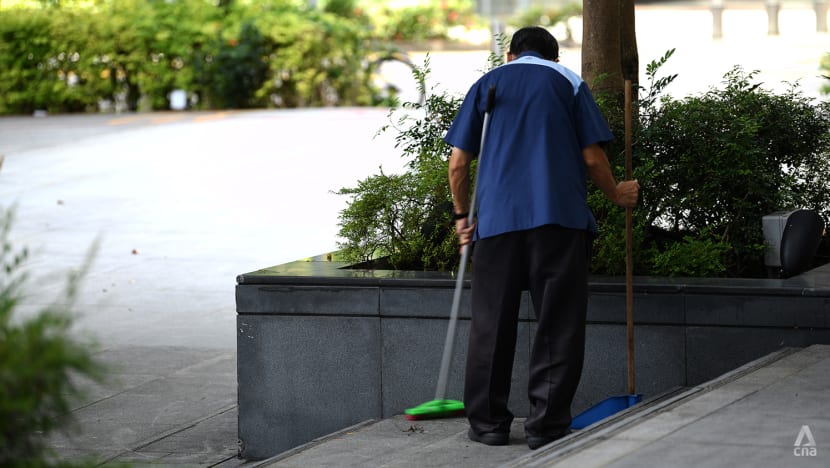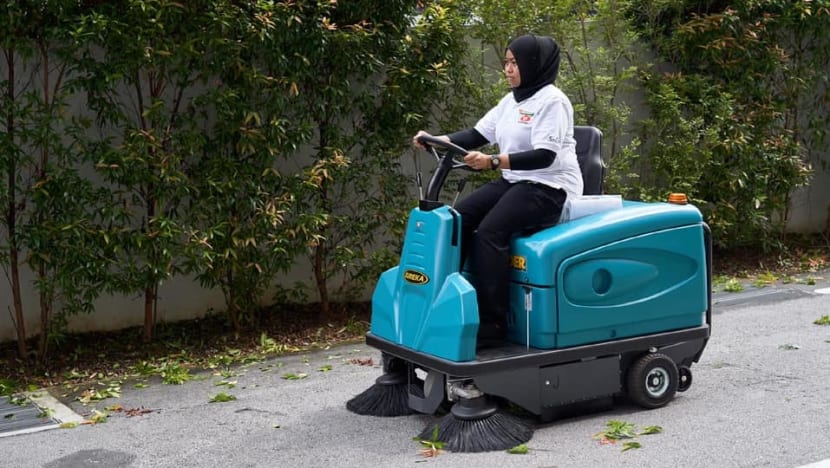Commentary: Cleaners are the unsung heroes of Singapore’s clean city
A recent survey showed that public satisfaction with cleanliness remains high in Singapore. Cleaners play a crucial role in this, says writer Richard Hartung.

Photo of a cleaner at a hawker centre. (Photo: Facebook/Ministry of Sustainability and the Environment)
SINGAPORE: Singapore is known as a clean city - one of the cleanest in the world.
According to a survey released by Singapore Management University earlier this month, satisfaction with overall public cleanliness in Singapore remains high at 92 per cent, although residents feel that coffee shops, hawker centres and toilets are not as clean as they used to be.
The nation takes its cleanliness seriously. The Keep Singapore Clean campaign was one of the first national campaigns Singapore launched as an independent nation, in 1968.
“No other hallmark of success will be more distinctive than that of achieving our position as the cleanest and greenest city in South Asia,” said founding prime minister Lee Kuan Yew as he launched the campaign in October 1968.
During the COVID-19 pandemic, the importance of public cleanliness became more critical. Every sector from public transport operators to town councils, hawker centres and private businesses stepped up efforts to sanitise and clean public spaces, residential areas, and offices.
Many cleaners worked long hours at the frontline of Singapore’s fight against the pandemic, facing COVID-19 exposure and increased workload.
A SHRINKING CLEANING WORKFORCE
Despite the increased demand for cleaning services, the issues of low pay and a shrinking cleaning workforce persist.
Cleaners play a crucial role in maintaining the cleanliness and hygiene of Singapore, but their remuneration does not always reflect the value of their work.
General and indoor cleaners such as those in an office or hawker centre are currently paid a basic monthly salary of S$1,312 (US$982) under the progressive wage model (PWM).
Come July, this will rise to S$1,570 for general cleaners in offices and commercial sites as well as those in F&B establishments, while those involved in conservancy cleaning will get S$1,795. By 2028, the basic entry-level wage in the cleaning business will reach at least S$2,420.
As the Tripartite Workgroup on Lower-Wage Workers noted in a report in 2021, Singapore should be a place where workers are able to progress with a sense of dignity regardless of where they start, and all Singaporeans can earn a decent living.
Are the wages of our cleaners enough for them to have a decent living? Would a higher salary attract more people to the industry, helping Singapore keep up its cleanliness goals?
PWM requirements started in the cleaning sector in 2014, with security and landscaping added in 2016, lift and escalator maintenance in 2019, retail in 2022. Food services PWM and occupational progressive wages for administrators and drivers were rolled out from March 2023, while waste management PWM will be implemented from July 2023.
In explaining PWM in 2014, former deputy prime minister Tharman Shanmugaratnam said cleaners in the resident workforce then earned about S$850 per month.
“Not only is that low pay, but most cleaners have also not enjoyed the real wage growth seen among workers nationally,” said Mr Tharman. He also said a defining feature of the PWM could be a “wage-skill ladder” that could see cleaners trained to use motorised ride-on equipment like sweepers or steam cleaners, enabling higher productivity.


HOW CAN THINGS BE IMPROVED
A fundamental issue with the PWM, University of Michigan professor emeritus Linda Lim said in an interview with SocialService.sg in 2020, is that it doesn’t deal with the root causes of the low wages.
Productivity in “low-skilled” occupations like cleaning is determined less by workers’ individual skills than by their equipment, job design and work organisation.
Employers can avoid paying PWM wage increases by hiring foreign workers, and may not be incentivised enough to invest in productivity-enhancing technologies and work organisation. While it is easy to point out the problems, and requiring training and calling for technology are good steps, the key is finding solutions for wages and productivity.
Employers can do more. Cleaning companies could benefit by pushing more employees to take classes sooner. The skills cleaners gain should help improve their productivity, which will benefit them and the company.
Employers could also leverage technology better to improve productivity. Government funding in this area would come in useful. For example, if companies in the PWM sectors had more technology grants for machines and software, this might push them to raise productivity.
Clients of the cleaners can also push for improvements. Professional cleaners trained in a variety of washing methods and techniques to keep offices or factory space in good condition can deliver a clean working environment that can boost mood levels and elevate productivity.
Clients of cleaning companies can demand better-trained workers who leverage better technology to provide the environment that boosts their own staff’s productivity.
Setting wages by considering factors including workers’ needs and the productivity they could achieve if employers provided the technology and training they needed, rather than basing compensation on current salaries, could lead to a better outcome for workers.
Enabling companies and workers to do more with less can provide tremendous benefits for cleaning companies, cleaners and anyone who uses the facilities that cleaners keep spotless.
Richard Hartung is a freelance writer who has resided in Singapore since 1992 and covers a wide range of local and international news.



















